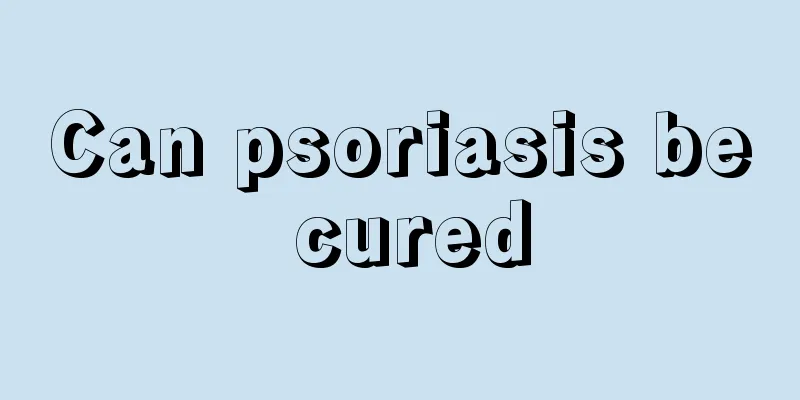A hard lump on your lower abdomen?

|
It is a very common phenomenon to have hard lumps on the lower abdomen. Many people have had similar symptoms. Generally speaking, hard lumps on the lower abdomen are likely to be caused by inflammatory infection. It is best to disinfect with iodine tincture in time and do a good job of local care. Try to eat light food, eat more nutritious foods, avoid spicy and irritating foods, keep the skin of the affected area clean and hygienic, and prevent infection and inflammation. What causes inflammation? Biological factors There are many causes of inflammation, including bacteria, viruses, rickettsia, mycoplasma, fungi, etc. Inflammation caused by biological pathogens is called infection. Exotoxins and endotoxins produced by bacteria can directly damage tissues; viruses replicate in infected cells, causing cell necrosis; certain antigenic pathogens damage tissues by inducing immune responses after infection, such as parasitic infections and tuberculosis. Physical factors High temperature, low temperature, radioactive substances, ultraviolet rays, and mechanical damage. Chemical factors Exogenous chemicals such as strong acids, strong alkalis, turpentine, mustard gas, etc. Endogenous toxic substances such as decomposition products of necrotic tissue and metabolic products that accumulate in the body under certain pathological conditions, such as urea. foreign body Some clothing that enters the body can also cause inflammation. For example, wood chips, dust particles, surgical sutures, metal, etc. These can all lead to varying degrees of inflammation. Necrotic tissue Ischemia or hypoxia can cause tissue necrosis, which is a potential inflammatory factor. The congested hemorrhagic bands and infiltration of inflammatory cells at the edge of fresh infarction are manifestations of inflammation. allergy When the body's immune response is abnormal, it can cause inappropriate or excessive immune responses, resulting in tissue and cell damage and leading to inflammation. Tissue damage caused by immune response is most common in various types of hypersensitivity reactions: type I allergic reactions such as allergic rhinitis and urticaria, type II allergic reactions such as anti-basement membrane glomerulonephritis, type III allergic reactions such as glomerulonephritis caused by immune complex deposition, type IV allergic reactions such as tuberculosis and typhoid fever; in addition, there are many autoimmune diseases such as lymphocytic thyroiditis and ulcerative colitis. Manifestations of inflammation red This is due to local congestion. Due to arterial congestion, the local oxygenated hemoglobin increases, which will appear bright red. Later, as inflammation develops, the oxygenated hemoglobin decreases, and the local tissue will turn dark red. swell In acute inflammation, local swelling is obvious, which is mainly caused by local congestion and inflammatory edema. Chronic inflammation is often caused by local hyperplasia. hot It is caused by local arterial congestion and enhanced metabolism, leading to increased heat production. It manifests as the temperature of the inflamed area on the body surface being higher than the surrounding tissues. It is not obvious when the internal organs are inflamed. pain Local pain during inflammation is related to many factors: ① The local decomposition metabolism of inflammation is enhanced, potassium ions and hydrogen ions accumulate, and stimulate nerve endings to cause pain; ② The effects of inflammatory mediators such as prostaglandins, bradykinin and other pain-causing substances; ③ Inflammatory exudation, local swelling, compression and traction of nerve endings cause pain, etc. Dysfunction During inflammation, factors such as parenchymal cell degeneration, necrosis, metabolic disorders, compression or mechanical obstruction of inflammatory exudates can all cause dysfunction of tissues and organs. For example, in viral hepatitis, liver cell degeneration and necrosis can cause liver dysfunction. In addition, pain can also affect function. For example, acute knee inflammation can limit knee joint movement due to pain. Systemic reactions Inflammatory lesions mainly occur locally, but local lesions are not isolated. They are affected by the functional state of the body and affect the whole body at the same time. fever Fever is more common in inflammation caused by pathogenic microorganisms. Fever is often prominent in infectious inflammation, especially when the pathogen spreads into the blood. Interleukin 1, tumor necrosis factor, and prostaglandin E produced by white blood cells can cause sympathetic nerve excitement, causing skin blood vessels to constrict, reducing heat dissipation and causing fever. White blood cell changes During inflammation, the bone marrow is stimulated by pathogenic microorganisms, toxins, metabolic products of the inflammatory area and products of white blood cell breakdown, which increases the production of white blood cells and increases the number of white blood cells in the peripheral blood. This is a defensive response of the body. |
>>: What to do if rhinitis and nasal congestion are very serious
Recommend
Which two places will show abnormalities in the early stage of gastric cancer
In the early stages of gastric cancer, two common...
What methods can cure motion sickness?
During holidays, people like to take a car to sce...
Prevention of lung cancer
Cancer does not occur suddenly. Animal experiment...
Benefits of safflower foot bath
Foot soaking is something that many people must d...
How to care after forehead augmentation with hyaluronic acid
If a person's forehead is not full enough, ev...
What are the examination methods for melanoma
Melanoma has become a skin disease that many frie...
What are the symptoms of pyloric spasm?
The main symptoms of pyloric spasm are abdominal ...
How to use Fengyoujing to treat athlete's foot
Athlete's foot is also called Hong Kong foot ...
Can I eat bird's nest after radiotherapy for nasopharyngeal carcinoma
Nasopharyngeal carcinoma is a malignant tumor. Cl...
What are the dangers of not treating hamartoma
The early symptoms of hamartoma are not obvious, ...
What to eat after esophageal cancer surgery to be good for your health
Although surgery is an effective method for treat...
What is the TSH value after hemisection of thyroid cancer
Thyroid cancer is a malignant tumor that originat...
How to know if you are suitable for canthus opening?
In today's society, many female friends with ...
Will too much earwax cause tinnitus? So that's how it is
Sometimes everyone feels that they have too much ...
Is lung cancer contagious? Pay special attention to these common lung cancer knowledge
The incidence of cancer has grown rapidly in rece...









